On Tuesday 13th September 2011, protesters against the worlds largest arms fair being held at the Exel Centre in East London brought their protests to some of the companies selling arms and to key sites including Parliament Square and th National Gallery which was hosting a dinner for the arms traders and their customers, including representatives of many of the most repressive regimes around the world.
Arms Fair Protest At Parliament, Old Palace Yard, Westminster

Around 250 people came to protest against the DSEI arms fair which was opening that day in East London. Many were people who had been protesting at the site of the fair during the previous week. The fair is the largest in the world, a private event supported by the UK government, and despite government denials, many deals are made there for illegal arms and arms are sold to some of the worlds most repressive regimes who use them against their own civilians.
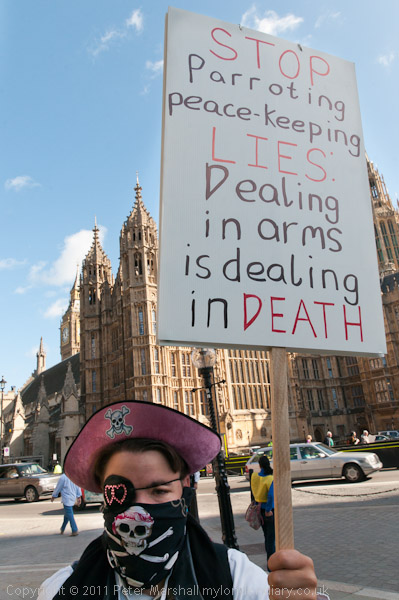
Many had come with posters and placards, but organisers CAAT (Campaign Against Arms Trade) came with fake arms to set up a supermarket where people could queue to buy riot gas, guided missiles, ammunition and other essentiaql supplies to keep their population down.
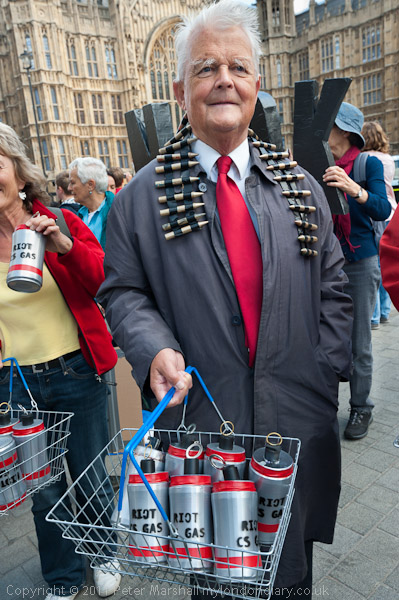
People held up letters spelling out ‘THIS IS NOT OK’ and then other posters and banners.
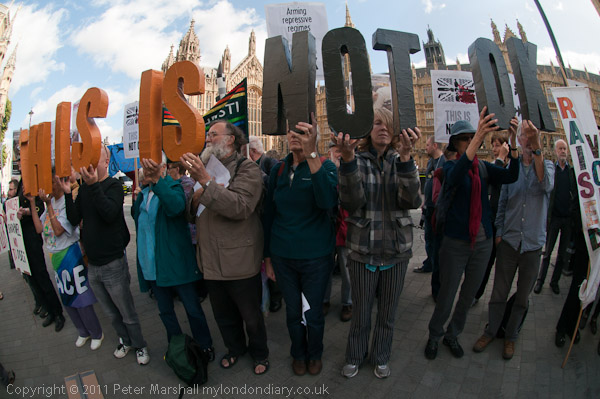
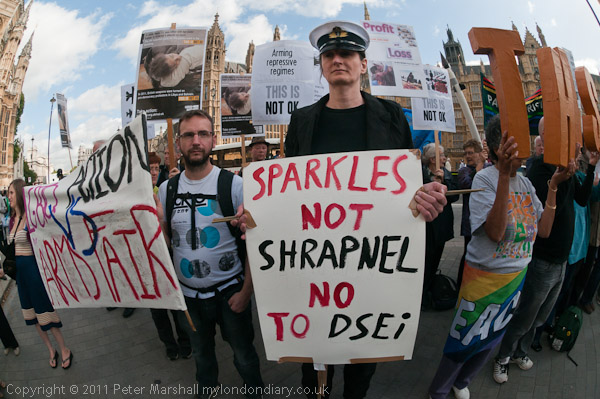
There were some songs, and anti-drone protesters staged a die-in as targets.
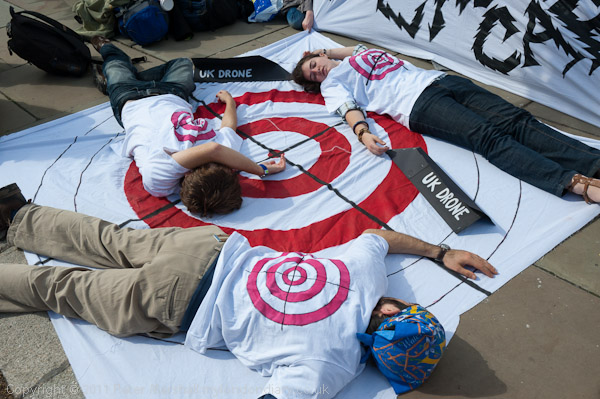
The country’s only Green MP (and one of the most sensible in the House of Commons) came to speak.
Dr Zig’s ‘Bubbles Not Bombs’ -Thames Embankment, Tate Modern.
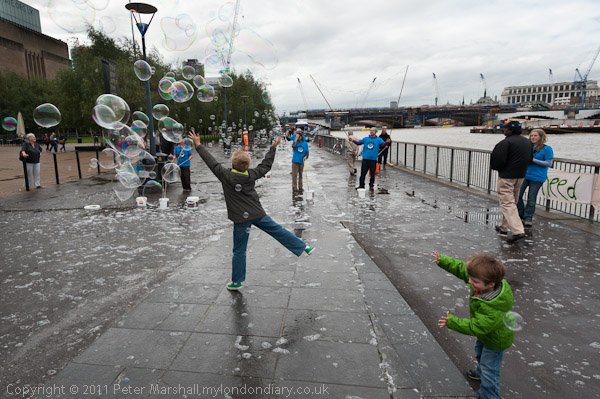
Those remarkable bubbers from Dr Zigs in Wales and made their “seriously HUGE bubbles” on the riverside walk outside Tate Modern, shouting “Bubbles not Bombs” as a child-friendly protest against the DSEi Arms Fair.
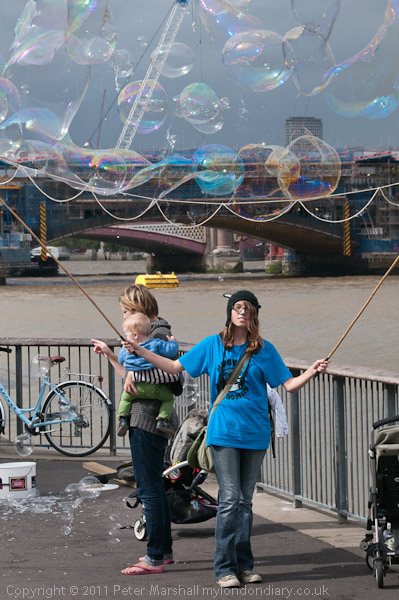
They say the DSEI fair is “where bad people the world over can come and buy the latest in guns, drones, warships etc.” and call for it to stop.
Dr Zig’s ‘Bubbles Not Bombs’ Protest
Secret Gardens of St John’s Wood
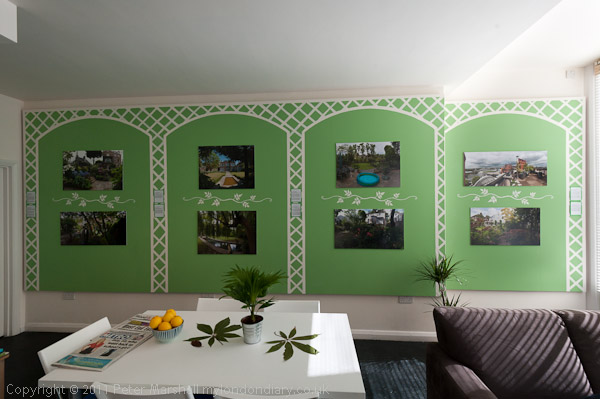
I just had time between protests to pop up to St John’s Wood and the Queens’s Terrace Café, where my show ‘Secret Gardens of St John’s Wood’ had been hung at the weekend when I had been too busy to be there. Jiro Osuga who had done the design and decoration and owner Mireille Galinou whose idea it had been had done a great job and it was ready for the opening.
Secret Gardens of St John’s Wood
Down the Drones Arms Fair Protest – Tower 42, Old Broad St
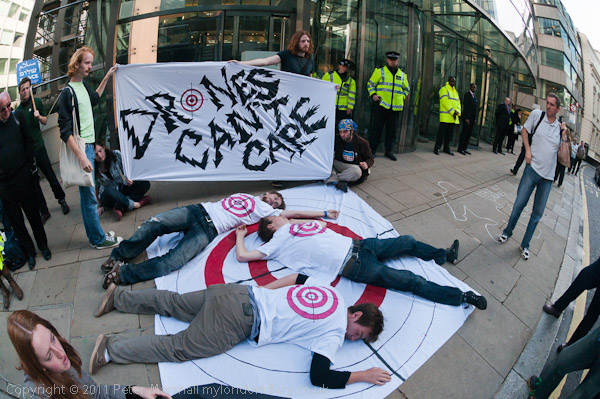
General Atomics ,makers of Predator and Reaper drones had their London office in Tower 42, still better known to many of us as the Nat West Tower, on Old Broad St Although there are wide areas of empty pavement most is land owned by Tower 42 and City police harassed protesters by ensuring they keep to the small area of public highway and then clearing them from most of it as they were then causing an obstruction.
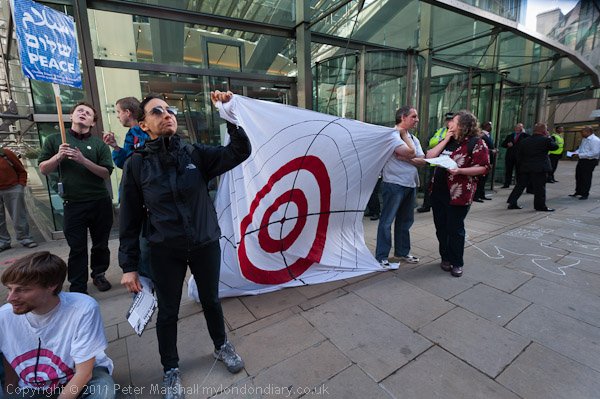
There seemed to me to be no good reason why the police shold enforce the civil property rights of the estate owner which would not be harmed by a small incursion, nor harass the protesters on the public highway when others could easily walk by – as many always do – on the private land.
The protesters managed to chalk slogans and body outlines on the pavement, displayed banners, sang and handed out leaflets to passers by about the dangers of militarism but were not allowed to lie down on their target and invite passers by to ‘zap’ them with a Playstation controller in their game of ‘Remote Control Killer Robots’.
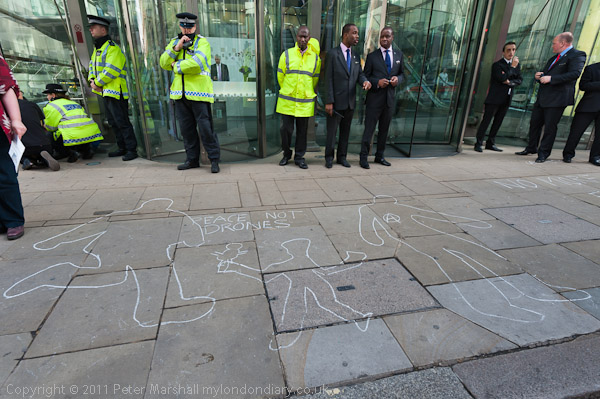
The US was then using around 48 Predator and Reaper drones in Iraq and Afghanistan, and the UK around 10 MQ-9 Reapers in Afghanistan, all controlled by pilots in an airforce base in Nevada. Various documents released by whistleblowers show that drone strike often take place on the basis of very limited and often unreliable evidence often killing innocent victims and any males in these countries who appear to be of military age and likely to be targets.
Using drones turns warfare for those ‘piloting’ them from a centre perhaps several thousands of miles from the battlefield into something very much like a computer game, removing any normal human inhibitions about the indiscriminate killing of others.
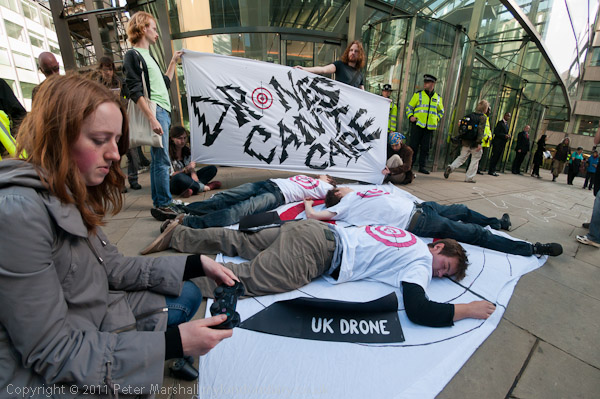
In the final few minutes police allowed three protesters to lie down on the pavement for a few seconds to enable photographers to take pictures.
Down the Drones City Arms Fair Protest
DSEi Protest at BAE Systems
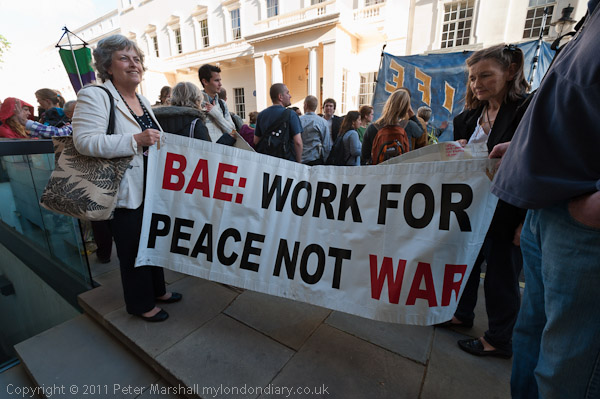
I’m not sure if there were any police for the protest outside BAE Systems in Carlton House Terrace which was the final advertised protest of the day. Perhaps the police were acting on advice from one of their plain clothes operatives who had told them there would be no trouble at this event.
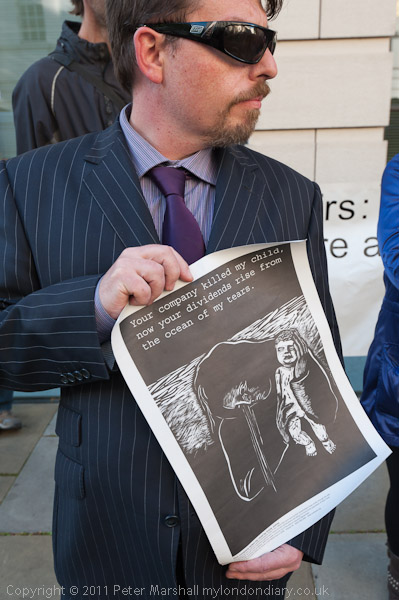
BAE Systems is Britain’s largest manufacturing companies, formed in 1999 by the merger of British Aerospace with parts of Marconi Electronics and traces its history back to 1560 and the Royal Gunpowder Mills at Waltham Abbey, over the years having incorporated many of the famous names in UK industry, particular those involved in aviation and arms manufacture. It also has a US subsidiary, BAE Systems, Inc. The company was a nationalised industry from 1977 to 1981, with the UK government in 1985 selling its remaining shares except for one very special £1 share which it can use to prevent it becoming foreign-owned.
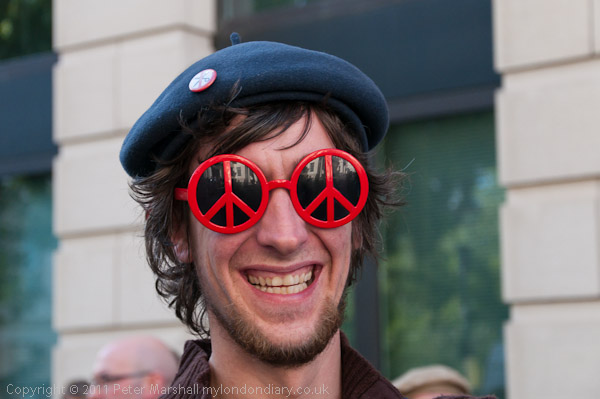
The company has been involved in a number of trade scandals, particularly over its deals with Saudi Arabia. Most recently in 2006 the Serious Fraud Office was forced by the Labour government to drop enquiries into bribery over an arms deal by BAE Systems with Saudi Arabia after a Saudi royal prince threatened cancellation of the order in 2006. The Campaign Against Arms Trade (CAAT) obtained a High Court decision that this government action breached the OECD Anti-Bribery Convention, but the government appealed and the law lords decided that national security should be an overriding principle and overturned the decision. So bribery, as well presumably as any other crime, is OK when it is in the national security interest.
The government’s decision to cancel the investigation was seen by most as an admission of BAE’s guilt in the matter, and they have also been under investigation for bribery in Chile, Romania, South Africa, Tanzania, the Czech Republic and Qatar and possibly elsewhere.
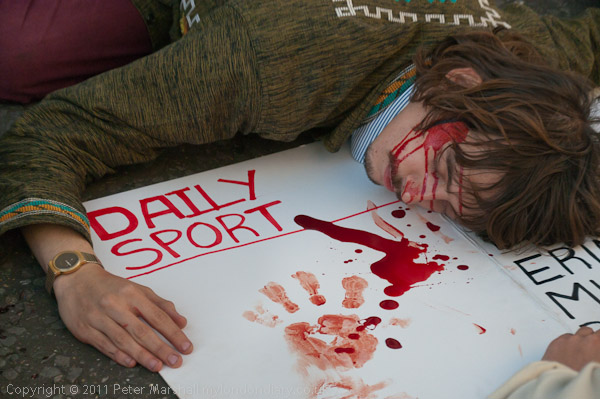
BAE systems are one of the world’s largest arms companies, producing fighter aircraft, warships, missiles and tanks along with other weapons. They are also one of the companies that will profit hugely from the replacement of Trident nuclear missiles, a high-spending and potentially dangerous project with no military significance.
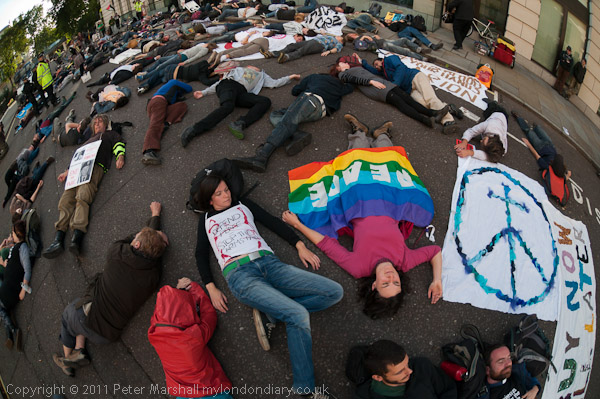
After some short speeches about BAE, almost all of those present laid flat on the pavement for a die-in before getting up and leaving. Although this was the last advertised protest for the day, a message bad been passed around that there would be an action at the National Gallery, which was hosting a dinner for those attending the DSEi arms fair.
Arms Fair Fracas At National Gallery
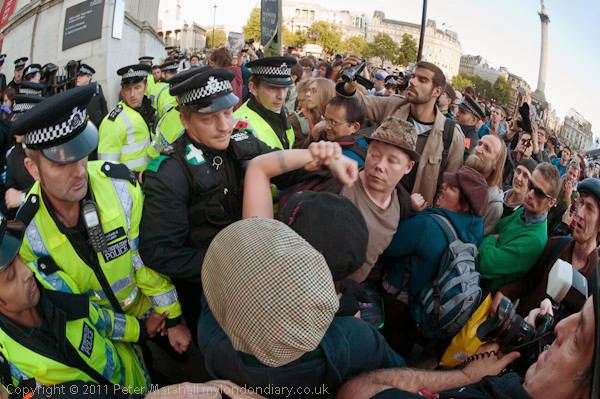
After a day of peaceful demonstrations against the DSEi Arms Fair in London, a fracas developed as police attempted to clear the National Gallery steps while a peaceful protest continued below in the North Terrace of Trafalgar Square. Well over a hundred protesters had come to the National Gallery as it was closing to protest at a dinner being given there for those attending the DSEi arms fair, including representatives of many of the most repressive regimes around the world.
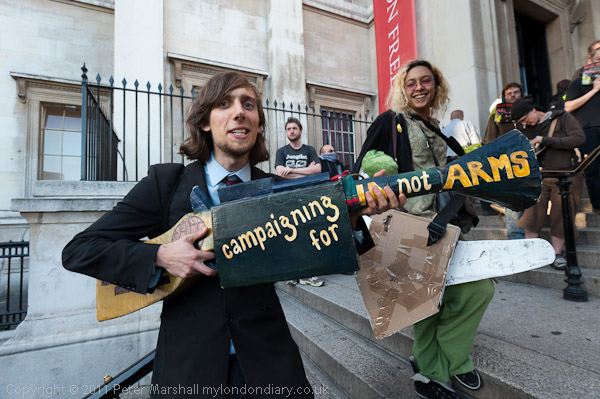
The protesters attempted to enter the Gallery as it was closing but were ushered out by security staff, and then began a peaceful protest on the steps of the gallery. Gallery staff asked protesters to leave the steps but some decided to stay and display banners there, while others continued to protest peacefully on the North Terrace in front of the gallery, displaying banners and holding a ‘die-in.
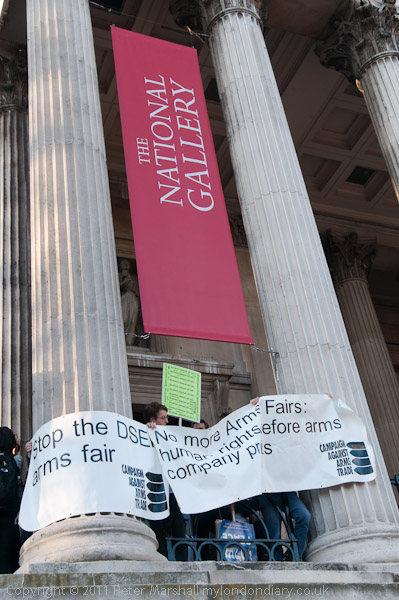
Eventually police got most of them moving slowly down the steps, though a few were still refusing to move. There was quite a lot of joking between some of the police and protesters and the atmosphere was generally friendly, although the protesters were not being very cooperative. Suddenly one of the protesters was seized and roughly carried away by police towards a nearby van. He did not appear to be formally arrested, and police would give no reason for his detention either to press, legal observers or protesters.
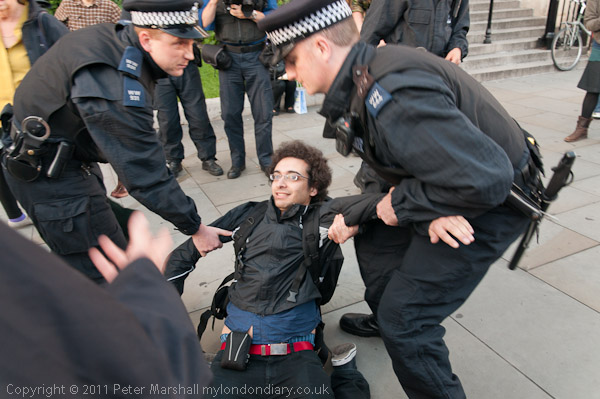
This changed the mood completely. Police reinforcements arrived and were able to force the protesters from the steps. There were a few incidents of what seemed thuggish violence towards both men and women. Some were arrested and dragged off to waiting vans; it was hard to be sure but their offence appeared to have been arguing and trying to protect themselves against police violence.
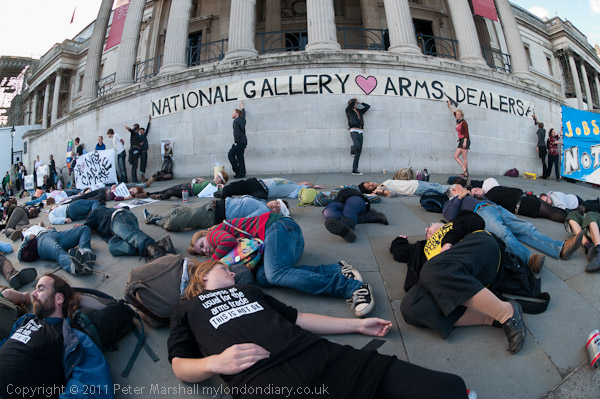
Meanwhile the protest continued peacefully on the North Terrace with a die-in and speakers explaining to the crowd that had gathered that the protest was calling for an end to UK arms sales to authoritarian regimes including Kuwait and Saudi Arabia, both responsible for the ruthless suppression of people in the ‘Arab Spring’ as well as countries involved in major armed conflicts and human rights abuses. I think many were shocked to learn that the UK was playing such a major part in this killing of people around the world – not something our media often dwell on.
Arms Fair Fracas At National Gallery







